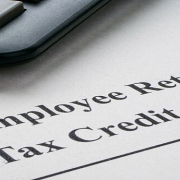IRS Offers Way Out For Businesses Worried About Employee Retention Credit Audits
Small-business owners worried about being hit with an audit over their Employee Retention Credit claim now have a way to back out.
The IRS announced Oct. 19 that it has officially created a special withdrawal process for businesses that have submitted an ERC application but have yet to receive any money.
The goal is to offer small-business owners a way out if they now feel they had been tricked or pressured into filing a misleading or ineligible claim — with withdrawn claims being treated as if they were never filed, the IRS said. Those who willfully filed a fraudulent claim or assisted or conspired in an effort to file false claims will still face potential criminal investigation or prosecution.
“The IRS is committed to helping small businesses and others caught up in this onslaught of Employee Retention Credit marketing,” said IRS Commissioner Danny Werfel in a press release. “The aggressive marketing of these schemes has harmed well-meaning businesses and organizations, and some are having second thoughts about their claims. We want to give these taxpayers a way out.”
How To Withdraw An ERC Claim
To take advantage of the claim withdrawal procedure, taxpayers should carefully follow the special instructions at IRS.gov/withdrawmyerc,
“For many, this is an unusual opportunity that lets taxpayers off the hook, and they are encouraged to consult their tax advisors on whether they can and should pursue this withdrawal process,” said Devin Tenney, a senior manager with Baker Tilly’s Washington National Tax Office, in an email to The Playbook.
The new withdrawal option comes after the IRS announced it was issuing a moratorium on processing new ERC applications in light of high levels of fraud perpetuated in part by third-party operators encouraging small-business owners to apply.
The IRS said it will continue to process ERC claims made before Sept. 14 but warned the processing times will be longer as they review them for fraud. That means a standard processing time of 90 days will double to 180 days or longer. The ERC was originally designed to reward business owners that kept staff on their payrolls during the Covid-19 pandemic, and businesses were eligible to receive up to $26,000 per employee.
The IRS laid out some additional guidelines for a withdrawal request. Small-business owners that used a professional payroll company to file their claim must consult with that payroll company, the IRS said. That company must submit the withdrawal request.
Business owners who have been notified they are under audit can send their withdrawal request to their assigned examiner or in response to the audit notice if no examiner has been assigned, the IRS said. Those who have received a refund check but have not cashed it or deposited it can still withdraw their claim by mailing the voided check alongside their withdrawal request.
Where Things Stand With ERC Claims
There were more than 600,000 claims currently awaiting processing, according to the IRS in September. As of July 31, the IRS had initiated 252 investigations involving over $2.8 billion of potentially fraudulent ERC claims. Of those, 15 have resulted in federal charges. And, of the 15 federally charged cases so far, six matters have resulted in convictions and four have reached the sentencing phase, with the average sentence being 21 months.
IRS Issued Several Warnings On ERC
Werfel, the IRS commissioner, spoke out against the program earlier this year, saying the agency would work with Congress to end the ERC early as it worked to combat a growing number of illegitimate claims.
The IRS has gradually ramped up its rhetoric on the program this year, including outlining a common misstep in the ERC for businesses that had a critical supplier shut down during 2020 or 2021. In specific cases, businesses that had a supplier shut down by a governmental order and could not get the part elsewhere would be eligible, but a recent IRS memo stresses how rare that would be.
In March, the IRS spotlighted the ERC as part of its “dirty dozen” list of tax scams, noting so-called “promoters” were flooding the internet, social media, TV and radio with ads and false promises. But while early warnings have focused on promoters encouraging ineligible businesses to apply or offering poor tax documentation, later warnings noted some social media and online advertisements exist solely as a way to scoop up large amounts of private information for identity theft. The IRS also issued another notice on how to spot potential ERC scams.
That means a lot of ads or “questionnaires” asking business owners to submit quick information online to see if they qualify were a way to get sensitive information with no intention of helping with the ERC at all.
The IRS initially released a notice about the ERC in 2022, warning small business owners against potential scams, and another on March 7.
Before the moratorium, businesses had until April 15, 2024, to get their ERC applications in for any quarter in 2020. Businesses would have had until April 15, 2025, for all quarters of 2021. As noted, businesses could potentially receive up to $26,000 per full-time employee from the ERC — although that’s not common.
Source: SFBJ






